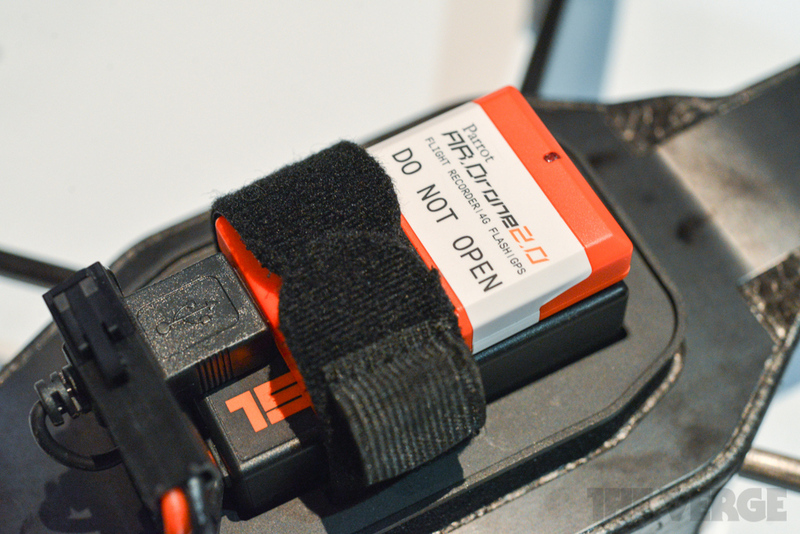Quadcopter AR.Drone - announced full-time GPS receiver. At last!
 Since the launch of the AR.Drone 2.0 quadrocopter from Parrot, its owners have been tormented by the lack of a GPS receiver in it, which deprived the drone of the opportunity to know its location, and also did not allow to implement such a function as an automatic return to the take-off place. Of course, aircraft models and enthusiasts did not sit idly by, but found ways to connect custom GPS modules to AR.Drone 2.0 via on-board USB. This required certain dances with driver firmware. But this year, AR.Drone manufacturing company - Parrot announced a full-time GPS receiver called Flight Recorder.
Since the launch of the AR.Drone 2.0 quadrocopter from Parrot, its owners have been tormented by the lack of a GPS receiver in it, which deprived the drone of the opportunity to know its location, and also did not allow to implement such a function as an automatic return to the take-off place. Of course, aircraft models and enthusiasts did not sit idly by, but found ways to connect custom GPS modules to AR.Drone 2.0 via on-board USB. This required certain dances with driver firmware. But this year, AR.Drone manufacturing company - Parrot announced a full-time GPS receiver called Flight Recorder. This is a device connected to the drone, which has 4GB of memory, a GPS receiver, adds the ability to fly along the route and much more.
Until now, in order to connect to the AR.Drone GPS, it was necessary to upgrade the drone's USB drivers and / or connect the Arduino to it, intruding into the gentle inner world of the drone, which was mainly the lot of desperate enthusiasts. After thinking about the popularity of such mods, Parrot apparently decided that this was a useful feature and announced the release of its own navigation device. Obviously, releasing AR.Drone 3.0 (or 2.0s? And now it's fashionable ...) for the sake of this function is hardly worth it, they decided to release the device as a plug-in. Fortunately, there is a USB port on board the drone. Initially, the USB port was intended exclusively for connecting external USB drives to record flight video on them. Now USB is used to connect the GPS module. At the same time, the module itself contains a 4GB flash drive, so it solves both tasks at once - GPS navigation and an external flash drive. Moreover, judging by the description, the module itself contains an USB input socket, which allows you to insert another USB flash drive if someone does not have enough 4GB. The module installed in the drone was shown at the last CES 2013 and looks as follows. Following the traditions of aviation black boxes, it has a bright orange color.

Using GPS, the flight data transmitted to the AR.Drone Academy will also include the coordinates, so that the flight path will be displayed in 3D.
What is interesting is that Parrot hasn’t stated anywhere that it intends to implement the function of returning the drone to the takeoff place in its applications.
A nice addition to the module is that it is compatible with the MAVLink protocol .and as a result can be integrated with open source systems like QGroundControl. And this makes it possible with the help of applications for Windows / Linux / Mac OS to create routes for flying the aircraft offline. So now it will be possible to boldly scare neighbors or launch drones to patrol the area (I’m already thinking about how this can be used in airsoft). Also, apparently, we should expect an update to the AR.Drone API to get the possibility of programmatic work with the module.
An easy concern for me personally is the fact that the module looks rather thick. In addition to the fact that the standard battery lasts only 12 minutes (this is according to the passport, in fact about 8mi), the AR.Drone often uses an extended battery with a capacity of 2300mAh (instead of a regular one with 1000mAh), which itself is also thick. Therefore, how the new module will be installed when using the extended battery is a question. Whether the standard cover will close while still not clear, it may be necessary to increase the size of the cavity with a cutting tool.
Only the new module is compatible with AR.Drone 2.0, as in the first version of the drone there is no USB. The price of the module and the release dates are still unknown, as well as the detailed specification of the device. But on the official website you can sign up for a notification about the availability of the module for ordering.
And to complete, a video from the official site:
